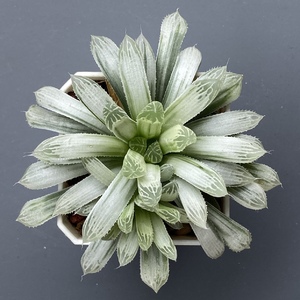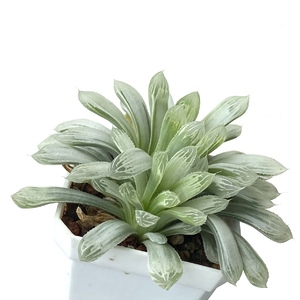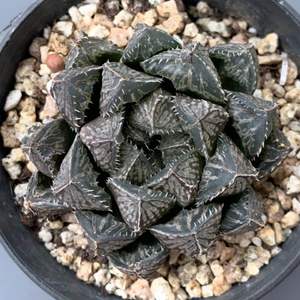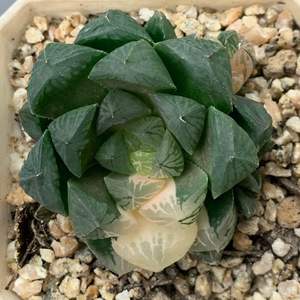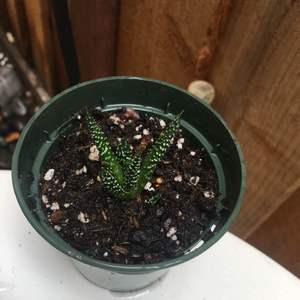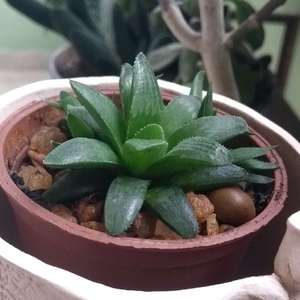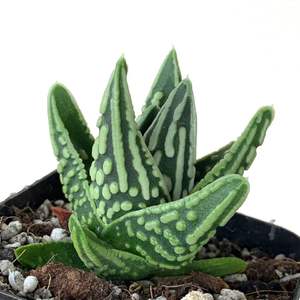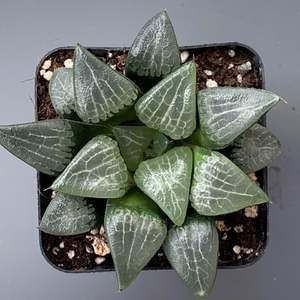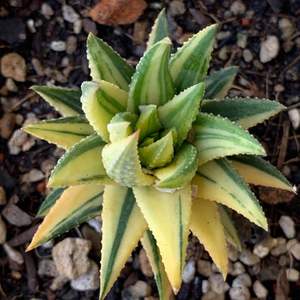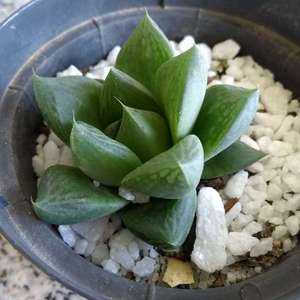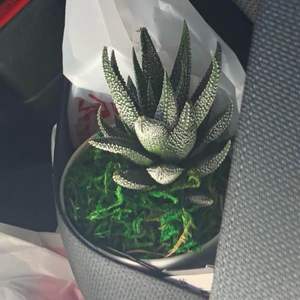文章
Miss Chen
2021年05月31日

Distribution and habitat: Haworthia venosa subsp. tessellata is a very widespread species, occurring in the climatically severe central-southern Africa and Namibia. It is one of the most adaptable, widespread and also variable Haworthia primarily found in the summer rainfall area. It grows on bushes and rocky areas. Usually it is very proliferous or stoloniferous, forming clusters in nature and filling in the space it has – shady place under the bush or in rock crevices. It is associated with other succulents such as Euphorbia aggregata, Cotyledon toxicaria, Crassula obvallata, Mesembriantemum saxicolum and Stapelia flavirostris.

Description: Haworthia venosa subsp. tessellata is one of the most widespread and also it is a very variable plant and in the past there were a huge number of names amongst this species (at least 26 varieties), but all this varieties merge gradually one with another through a continuous series of transitional forms, so now they are all called Haworthia venosa subsp. tessellata .
It is a succulent evergreen slow-growing species reaching a size of 15cm (6 inch) in height. This plant is stemless, low 5-10cm (2-4 inch) in diameter with about 7-15 leaves arranged in spirals. The leaves are sessile 3-5cm (1-2 inch) long, 2-3cm (0.8-1 inch) wide at the base, fleshy, firm in texture, broadly triangular, strongly recurved, brownish to green, cuspidate at the apex; upper surface flattish, marked with six pale green anastomosing verticallines forming a square patterned design and windowed (sunlight enters the plant body through these translucent windows and is converted into energy by many layers of chlorophyll-rich cells), lower surface is usually rounded slightly scabrid with raised coriaceous tubercles, especially in the upper part where they are arranged in transverse rows, margins with recurved white teeth. The leaves are greenish, form a rosette and turn to reddish in full sun.
This stemless plant sends underground stolons up to 14cm (6 inch) away from the mother plant. This vegetative reproduction results in a mat of plants and produce clones of parent plant.
Small tubular white flowers with green bibs appear in summer time on a few flowered simple raceme up to 50cm (20 inch) tall.
Houseplant care: Haworthia venosa subsp. tessellata in cultivation it grows quite easily, spreading by offsetting and via stolons.
Light: Haworthia venosa subsp. tessellata will take various light conditions, but neither direct sunlight or deep shade. If given it the right amount of sun light, the nice markings will be more visible and plants more attractive.
It is recommended to stand these plants outside in summer in a place where they can get some indirect sun light.
Temperature: Normal room temperatures are satisfactory at all times, but Haworthia venosa subsp. tessellata do best if winter temperatures are kept about 15°C (59°F). They have a rest period from mid-winter to late spring and can survive temperatures down to 4-5°C (39-41°F). They do prefer more warmth even while resting in winter and spring, however.
Watering: Haworthia venosa subsp. tessellata is very tolerant of underwatering, but will succumb quickly to rotting if overwatered. During the active growth period water moderately, enough to make the potting mixture moist throughout but allowing the top centimeter or so to dry out between waterings. During the rest period water only enough to prevent the potting mixture from drying out completely.
Their growing season tends to be during the winter months and roots are often lost during summer months. Watering at the wrong time of year may kill the plant, so some sensitivity to the active growing cycle is required.
Feeding: Haworthia venosa subsp. tessellata thrives with very occasionally and should only be fertilised using a weak solution.
Potting and repotting: Haworthia venosa subsp. tessellata has a slow rate of growth, therefor repotting is only required infrequently and usually only when offsets have filled the pot. Half-pots are best suited to the clustering habit of Haworthia venosa subsp. tessellata plants. When pot a specimen always leave a 4-5cm space between the edges of the cluster and the rim of the pot to allow room for new growth.The largest pot size needed will be 12-15cm (5-6 inch). A plant that has grown beyond that size should be split up.
Repot in spring at the start of the growth period. Use a porous potting mixture composed of one part of coarse sand or perlite to two parts of standard soil-based mixture. After pulling or cutting off any dead or shriveled leaves, move each plant into a larger pot only if the rosette cluster covers the entire surface of the potting mixture.
Gardening: Outdoors Haworthia venosa subsp. tessellata plants do fairly well in zones 9b-10b in arid climates. They make fairly decent landscape plants filling small areas between rocks nicely. But they often get lost in complicated and overgrown gardens and then suffer from lack of light. To overcome such situations it is recommended to grow Haworthia venosa subsp. tessellata in pots.
Haworthia venosa subsp. tessellata in wild are nearly buried in the soils with only the leaf-tops exposed. They do not need to be planted this way in pots and look a lot nicer with at least some leaves sticking out above the soils.
Position: The more light the better, partial day sun to light shade is the optimum light intensity needed for Haworthia venosa subsp. tessellata plants. Also, these plants will grow well in a greenhouse.
Soil: Haworthia venosa subsp. tessellata need a well draining soil and a layer of top dressing.
These plants need mildly acidic soil. Use cactus compost or add sand to improve the garden soil drainage. Warm climates may require more water-retention properties than cool or indoor climates.
Top dressing is a good idea, not just for looks, but helps to keep the plant’s leaves off from the wet soil, promotes drainage through the soil and help preserving the water into the soil.
Irrigation: Watering varies depending on the plants position and temperature. Water them frequently when it is warm and dry (but not at the very peak of the heat- they seem to go through a period of summer dormancy at this time) and less to not at all in winter when it is cold… however, Haworthia venosa subsp. tessellata plants or pots with succulent plants communities are sitting under the grey skies of winter storms and get a lot of rainwater at a time when they are probably mostly dormant. It seems that it is not be a problem for these plants.
Individual plants in smaller pots demand more attention. Water ideally when soil is getting dry and not if wet. When in doubt, best to skip watering… too much is worse than too little. Some pots dry out faster than others, too (if glazed, unglazed terracotta, metal, glass etc – all dry out at different rates).
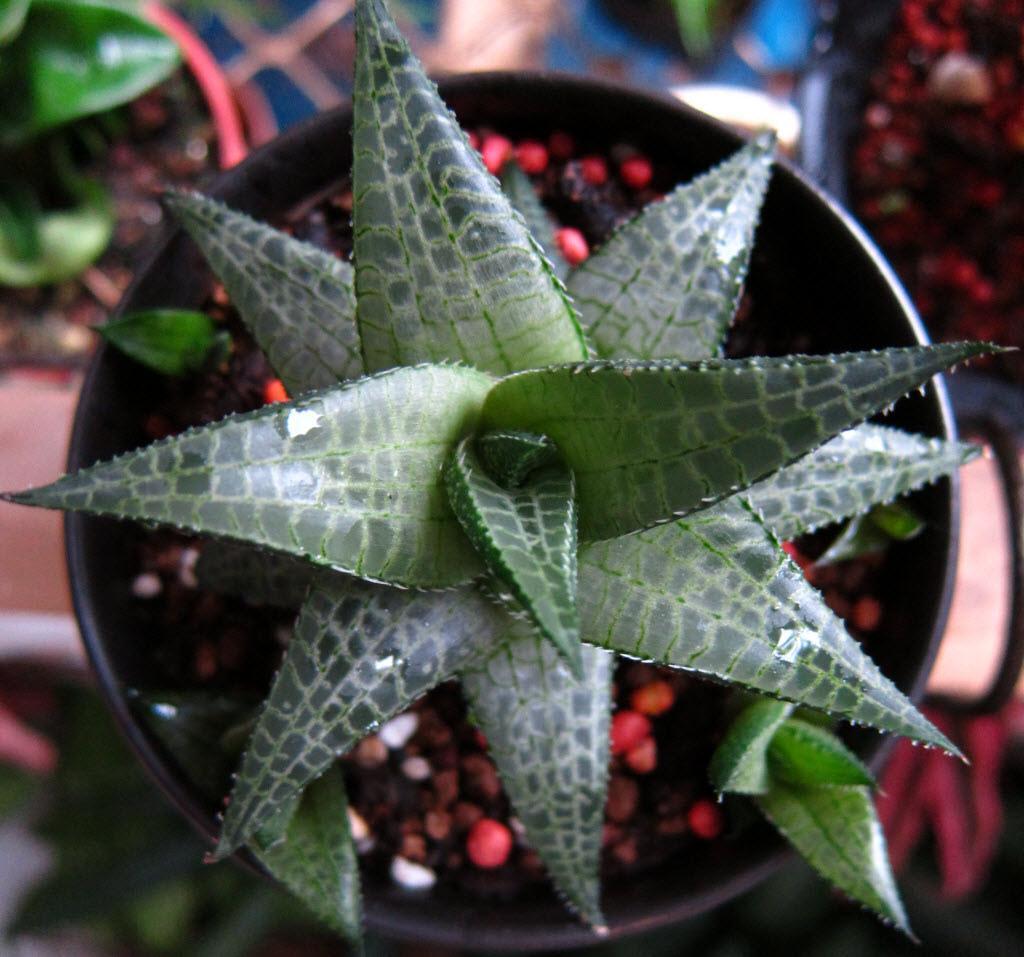
Fertilising: Some experts recommend just repotting every few years and that will pretty much negate the need for fertilizer.
Propagation: Haworthia venosa subsp. tessellata can be propagated by seed or offsets.
Most Haworthia venosa subsp. tessellata plants will eventually offset and those offsets are easy to separate and produce a new plant. This way of propagation will result in new plant identical with the parent plant. When cutting off an offset without roots, best to let it dry over three days or so before replanting it again. Press it on slightly moist soil and keep it in warm area and keep out of sun. Summer is the best moment to separate the offsets. They will root into the soil.
Haworthia venosa subsp. tessellata grow readily from seed. These plants have a tendency to hybridise so easily that the results are likely to be unpredictable.
The flowers of Haworthia venosa subsp. tessellata need pollination in order to produce seeds and artificial pollination is very effective. It is easy to create all sorts of Haworthia hybrids by transferring pollen from flower to flower, plant to plant.
Problems: Haworthia venosa subsp. tessellata is generally disease free.
These plants may need to be re-rooted (get rooting hormone) in an evenly warm, well lit but protected environment. Once it is rooted well, it can go back out into the general collection for more abuse.
Exposure to direct sunlight of unaccustomed plants can lead to severely sunburn and subsequently may rot.
Grown in low light for much of the year can create etiolated, weakened and abnormally green plants.
Meallybugs may be a problem. It is their main pest.
Occasional watering with systemic insecticides based on Imidacloprid will keep the plants free of mealy bugs.
Note: The Latin name tessellata comes from the tiled pattern in the leaf faces. Sunlight enters the plant body through these translucent windows and is converted into energy by many layers of chlorophyll-rich cells. This is especially useful in the arid climates where Haworthia venosa subsp. tessellata makes its living as the primary photosynthesis tissues are not exposed to the drying elements.
Companion plants: Haworthias species are small succulent plants closely related to Aloe, Gasteria, Kniphofia, Poellnitzia and Astroloba species.
Uses and display: Haworthia venosa subsp. tessellata are generally grown for their decorative leaf markings and architectural forms. They are suitable for patio landscapes and as container plants, being an attractive, easy plant for a pan. They are compact plants so can easily be grouped in different sized containers to add visual appeal.
SUMMARY:
CHARACTERISTICS:
Foliage – coloured
Shape – rosette
Height: 15cm (6 inch)
PROPER CARE:
Watering in rest period – sparingly
Watering in active growth period – moderately
Light – medium
Temperature in rest period – min 4°C max 18°C (39-59°F)
Temperature in active growth period – min 16°C max 24°C (61-75°F)
Humidity – low
Hardiness zone: 9b-11

Description: Haworthia venosa subsp. tessellata is one of the most widespread and also it is a very variable plant and in the past there were a huge number of names amongst this species (at least 26 varieties), but all this varieties merge gradually one with another through a continuous series of transitional forms, so now they are all called Haworthia venosa subsp. tessellata .
It is a succulent evergreen slow-growing species reaching a size of 15cm (6 inch) in height. This plant is stemless, low 5-10cm (2-4 inch) in diameter with about 7-15 leaves arranged in spirals. The leaves are sessile 3-5cm (1-2 inch) long, 2-3cm (0.8-1 inch) wide at the base, fleshy, firm in texture, broadly triangular, strongly recurved, brownish to green, cuspidate at the apex; upper surface flattish, marked with six pale green anastomosing verticallines forming a square patterned design and windowed (sunlight enters the plant body through these translucent windows and is converted into energy by many layers of chlorophyll-rich cells), lower surface is usually rounded slightly scabrid with raised coriaceous tubercles, especially in the upper part where they are arranged in transverse rows, margins with recurved white teeth. The leaves are greenish, form a rosette and turn to reddish in full sun.
This stemless plant sends underground stolons up to 14cm (6 inch) away from the mother plant. This vegetative reproduction results in a mat of plants and produce clones of parent plant.
Small tubular white flowers with green bibs appear in summer time on a few flowered simple raceme up to 50cm (20 inch) tall.
Houseplant care: Haworthia venosa subsp. tessellata in cultivation it grows quite easily, spreading by offsetting and via stolons.
Light: Haworthia venosa subsp. tessellata will take various light conditions, but neither direct sunlight or deep shade. If given it the right amount of sun light, the nice markings will be more visible and plants more attractive.
It is recommended to stand these plants outside in summer in a place where they can get some indirect sun light.
Temperature: Normal room temperatures are satisfactory at all times, but Haworthia venosa subsp. tessellata do best if winter temperatures are kept about 15°C (59°F). They have a rest period from mid-winter to late spring and can survive temperatures down to 4-5°C (39-41°F). They do prefer more warmth even while resting in winter and spring, however.
Watering: Haworthia venosa subsp. tessellata is very tolerant of underwatering, but will succumb quickly to rotting if overwatered. During the active growth period water moderately, enough to make the potting mixture moist throughout but allowing the top centimeter or so to dry out between waterings. During the rest period water only enough to prevent the potting mixture from drying out completely.
Their growing season tends to be during the winter months and roots are often lost during summer months. Watering at the wrong time of year may kill the plant, so some sensitivity to the active growing cycle is required.
Feeding: Haworthia venosa subsp. tessellata thrives with very occasionally and should only be fertilised using a weak solution.
Potting and repotting: Haworthia venosa subsp. tessellata has a slow rate of growth, therefor repotting is only required infrequently and usually only when offsets have filled the pot. Half-pots are best suited to the clustering habit of Haworthia venosa subsp. tessellata plants. When pot a specimen always leave a 4-5cm space between the edges of the cluster and the rim of the pot to allow room for new growth.The largest pot size needed will be 12-15cm (5-6 inch). A plant that has grown beyond that size should be split up.
Repot in spring at the start of the growth period. Use a porous potting mixture composed of one part of coarse sand or perlite to two parts of standard soil-based mixture. After pulling or cutting off any dead or shriveled leaves, move each plant into a larger pot only if the rosette cluster covers the entire surface of the potting mixture.
Gardening: Outdoors Haworthia venosa subsp. tessellata plants do fairly well in zones 9b-10b in arid climates. They make fairly decent landscape plants filling small areas between rocks nicely. But they often get lost in complicated and overgrown gardens and then suffer from lack of light. To overcome such situations it is recommended to grow Haworthia venosa subsp. tessellata in pots.
Haworthia venosa subsp. tessellata in wild are nearly buried in the soils with only the leaf-tops exposed. They do not need to be planted this way in pots and look a lot nicer with at least some leaves sticking out above the soils.
Position: The more light the better, partial day sun to light shade is the optimum light intensity needed for Haworthia venosa subsp. tessellata plants. Also, these plants will grow well in a greenhouse.
Soil: Haworthia venosa subsp. tessellata need a well draining soil and a layer of top dressing.
These plants need mildly acidic soil. Use cactus compost or add sand to improve the garden soil drainage. Warm climates may require more water-retention properties than cool or indoor climates.
Top dressing is a good idea, not just for looks, but helps to keep the plant’s leaves off from the wet soil, promotes drainage through the soil and help preserving the water into the soil.
Irrigation: Watering varies depending on the plants position and temperature. Water them frequently when it is warm and dry (but not at the very peak of the heat- they seem to go through a period of summer dormancy at this time) and less to not at all in winter when it is cold… however, Haworthia venosa subsp. tessellata plants or pots with succulent plants communities are sitting under the grey skies of winter storms and get a lot of rainwater at a time when they are probably mostly dormant. It seems that it is not be a problem for these plants.
Individual plants in smaller pots demand more attention. Water ideally when soil is getting dry and not if wet. When in doubt, best to skip watering… too much is worse than too little. Some pots dry out faster than others, too (if glazed, unglazed terracotta, metal, glass etc – all dry out at different rates).

Fertilising: Some experts recommend just repotting every few years and that will pretty much negate the need for fertilizer.
Propagation: Haworthia venosa subsp. tessellata can be propagated by seed or offsets.
Most Haworthia venosa subsp. tessellata plants will eventually offset and those offsets are easy to separate and produce a new plant. This way of propagation will result in new plant identical with the parent plant. When cutting off an offset without roots, best to let it dry over three days or so before replanting it again. Press it on slightly moist soil and keep it in warm area and keep out of sun. Summer is the best moment to separate the offsets. They will root into the soil.
Haworthia venosa subsp. tessellata grow readily from seed. These plants have a tendency to hybridise so easily that the results are likely to be unpredictable.
The flowers of Haworthia venosa subsp. tessellata need pollination in order to produce seeds and artificial pollination is very effective. It is easy to create all sorts of Haworthia hybrids by transferring pollen from flower to flower, plant to plant.
Problems: Haworthia venosa subsp. tessellata is generally disease free.
These plants may need to be re-rooted (get rooting hormone) in an evenly warm, well lit but protected environment. Once it is rooted well, it can go back out into the general collection for more abuse.
Exposure to direct sunlight of unaccustomed plants can lead to severely sunburn and subsequently may rot.
Grown in low light for much of the year can create etiolated, weakened and abnormally green plants.
Meallybugs may be a problem. It is their main pest.
Occasional watering with systemic insecticides based on Imidacloprid will keep the plants free of mealy bugs.
Note: The Latin name tessellata comes from the tiled pattern in the leaf faces. Sunlight enters the plant body through these translucent windows and is converted into energy by many layers of chlorophyll-rich cells. This is especially useful in the arid climates where Haworthia venosa subsp. tessellata makes its living as the primary photosynthesis tissues are not exposed to the drying elements.
Companion plants: Haworthias species are small succulent plants closely related to Aloe, Gasteria, Kniphofia, Poellnitzia and Astroloba species.
Uses and display: Haworthia venosa subsp. tessellata are generally grown for their decorative leaf markings and architectural forms. They are suitable for patio landscapes and as container plants, being an attractive, easy plant for a pan. They are compact plants so can easily be grouped in different sized containers to add visual appeal.
SUMMARY:
CHARACTERISTICS:
Foliage – coloured
Shape – rosette
Height: 15cm (6 inch)
PROPER CARE:
Watering in rest period – sparingly
Watering in active growth period – moderately
Light – medium
Temperature in rest period – min 4°C max 18°C (39-59°F)
Temperature in active growth period – min 16°C max 24°C (61-75°F)
Humidity – low
Hardiness zone: 9b-11
0
0
文章
Miss Chen
2021年05月28日

Distribution and habitat: Haworthia is a genus of small succulent plants endemic to Southern Africa. Like the Aloes, they are members of the subfamily Asphodeloideae and they generally resemble miniature aloes, except in their flowers, which are characteristic in appearance. They are popular garden and container plants.
Haworthia pumila occurs in a winter rainfall area, which experiences mild frost, -2°C (28°F). Summers are hot, up to 44°C (111°F). Rainfall varies from 150mm (6 inch) (Worcester area) to 350mm (14 inch) (Montagu area). Haworthia pumila is not an endangered plant.
Description: Haworthia pumila is one of the most impressive and eventually large species of the genus. Haworthia pumila has triangular, rather tough, dark green leaves thickly spotted with pearly white warts. Stems are very short and the many leaved rosettes, which can attain a diameter of 15cm (6 inch) and a height of 7-10cm (3-4 inch), appears to be stemless. A cluster of rosettes form quickly (within about a year). The lower, older leaves of each rosette stand erect, but younger ones toward of the rosette centre curve inward. The 7mm (0.3 inch) thick leaves are about 9cm (3 inch) long and 3cm (1 inch) wide at the base. Leaf upper surfaces are flat, while the undersides are keeled toward the tips.
The flowers are somewhat larger than in other species, greenish to brownish-white in colour and waxy in texture (usually Haworthia flowers are white, but not in this case). The booming season is early summer and seed ripens in autumn.
Houseplant care: Haworthia pumila are classified as succulent – which means that they can cope with relatively harsh waterless hot environments. They are however not frost hardy, which means that for cultivation they need over the winter season either a sunny windowsill or preferably a greenhouse.
They are relatively slow-growing plants that offsets to form small clusters with time.
Light: Never place Haworthia pumila in direct sunlight. If exposed to summer sun, foliage will shrivel. Medium light suits this plant at all times. When the plants are provided with enough light, than the white tubercles from the leaves became more attractive.
It is recommended to move these house plants outdoors for the summer months. Place them in light shaded area, but out of direct sun which can scorch its leaves.
Temperature: Normal room temperatures 18-24°C (65-75°F) spring through fall. They have a rest period from mid-winter to late spring and can survive temperatures down to 4-5°C (39-41°F). In winter, if possible, keep Haworthia pumila cooler – around 15°C (59°F) is the optimum winter temperature for this plant.
Water: During the active growth period water moderately, enough to make the potting mixture moist throughout but allowing the top centimeter (0.4 inch) or so to dry out between waterings. During the rest period water only enough to prevent the potting mixture from drying out completely. Never let the potting mixture become completely dry, however. Although Haworthia pumila are succulent plants, they cannot survive total drought.
Feeding: It is neither necessary nor advisable to feed Haworthia pumila .
Longevity: Haworthia pumila plants live for about 30 to 40 years if they are cultivated properly.
Potting and repotting: Use a porous potting mixture composed of one part of coarse sand or perlite to two parts of standard soil-based mixture. Since Haworthia pumila plants are shallow rooted, half-pots are best suited to the clustering habit of the plants. In potting a specimen always leave a 4-5cm (1.5-2 inch) space between the edges of the cluster and the rim of the pot to allow room for new growth.
Repot in spring at the start of the growth period. After pulling or cutting off any dead or shriveled leaves, move each plant into a larger pot only if the rosette cluster covers the entire surface of the potting mixture. The largest pot size needed will be 12-15cm (5-6 inch). A plant that has grown beyond that size should be split up.
Gardening: Although the plant will survive mild frost if kept dry – hardy as low -2°C (28°F) – it should be protected from severe cold and prolonged frost conditions.
Position: Haworthia pumila requires light shade to bright light, protected from strong midday sun. In shade the body colour will remain mostly green, while full sun will darken it and give it red/brown body colour.
The amount of sunlight it can withstand without scorching depends upon the how hot it becomes in the summer in the locale in which it is planted. It will have more colour if it receives more light. During the spring it may be able to take full sun until the heat arrives at the end of spring. In an area that has hot afternoon sun, it may be able to take full morning sun, but requires afternoon shade or afternoon light shade. Can be sunburned if moved from shade/greenhouse into full sun too quickly.
Soil: Haworthia pumila are tolerant of a wide range of soils and habitats, but prefer a very porous potting mix to increase drainage. A non-acid soil is ideal.
Irrigation: Watering varies depending on the plants position and temperature. Water them frequently when it is warm and dry (but not at the very peak of the heat- they seem to go through a period of summer dormancy at this time) and less to not at all in winter when it is cold. However, Haworthia pumila plants or pots with succulent plants communities are sitting under the grey skies of winter storms and get a lot of rainwater at a time when they are probably mostly dormant. It seems that it is not be a problem for these plants.
Individual plants in smaller pots demand more attention. Water ideally when soil is getting dry and not if wet. When in doubt, best to skip watering as too much is worse than too little. Some pots dry out faster than others, too (if glazed, unglazed terracotta, metal, glass etc – all dry out at different rates).
Fertilising: Do NOT fertilize newly potted plants for the first year. After that, fertilize once in spring, once in fall with diluted fertiliser at half the recommended strength. Avoid summer fertilizing as plant is in a short rest period.
Propagation: Remove the offsets in summer; they should pull away easily. Pot up immediately any offset with roots already attached and treat it as a mature plant.
Allow an offset without roots to dry for three days, however, then press it into the potting mixture. At this stage it should be possible to treat the new plant as an adult Haworthia pumila.
To propagate by leaf cuttings, remove a leaf and let it lie for about one month, giving the wound time to heal. Then lay the leaf on its side with the basal part buried in the soil. This leaf should root within a month or two, and small plants will form at the leaf base.
Haworthia pumila grow readily from seed. These plants have a tendency to hybridize so easily, however, that the results are likely to be unpredictable. Haworthia pumila grows relatively slowly from seed and it takes about 5 years for a plant to reach flowering maturity.
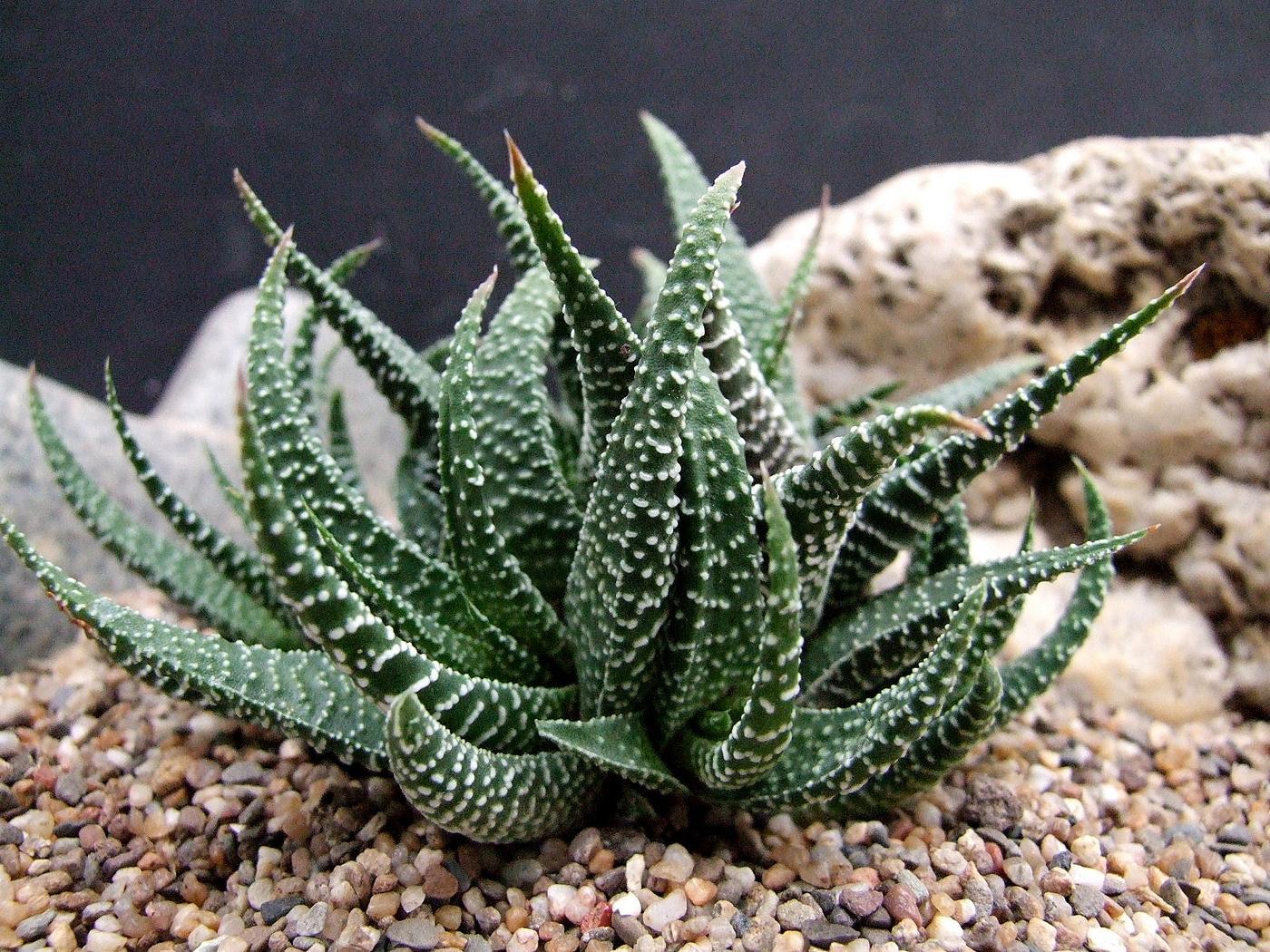
Problems: Given correct treatment, this plant is generally trouble free.
Stunted growth may indicate mealy bags infestation.
Treatment: Occasional watering with systemic insecticides based on Imidacloprid will keep the plants free of mealy bugs.
Rot is only a minor problem with Haworthia if the plants are watered and “aired” correctly. Haworthia species can lose their roots periodically. They can rot with too much moisture, especially when there is a sudden temperature drop.
Treatment: There are two ways to handle this:
1. Simply leave the plant on its side and when ‘bumps’ which are the new roots start to appear (It may take a few weeks), pot the plant in soil and water normally. Mist it occasionally for encouragement.
2. The second method is more like how it happens in nature and is my preferred method. Be sure the plant is in well-draining soil and water normally. In a month or so, gently tug and feel the roots taking hold–if the roots are not holding, don’t worry. Just put the plant back in the soil and wait a little longer.
If the plant has lost its roots and is severely dehydrated at the same time, it may be too far gone to save. But always it is worth a try.
When watering, avoid getting the leaves wet. Like other succulents, it is prone to rot if its leaves get too wet. If they are not, fungicides won’t help all that much. Care must be given in watering, keeping them warm and wet while growing and cooler and dry when dormant.
Reddish colour can mean many things besides root loss. Many of Haworthia turn red when the temperature drops or when they get too much sunlight. A plant can loose their reddish colour turning in green later as the environment condition are changed.
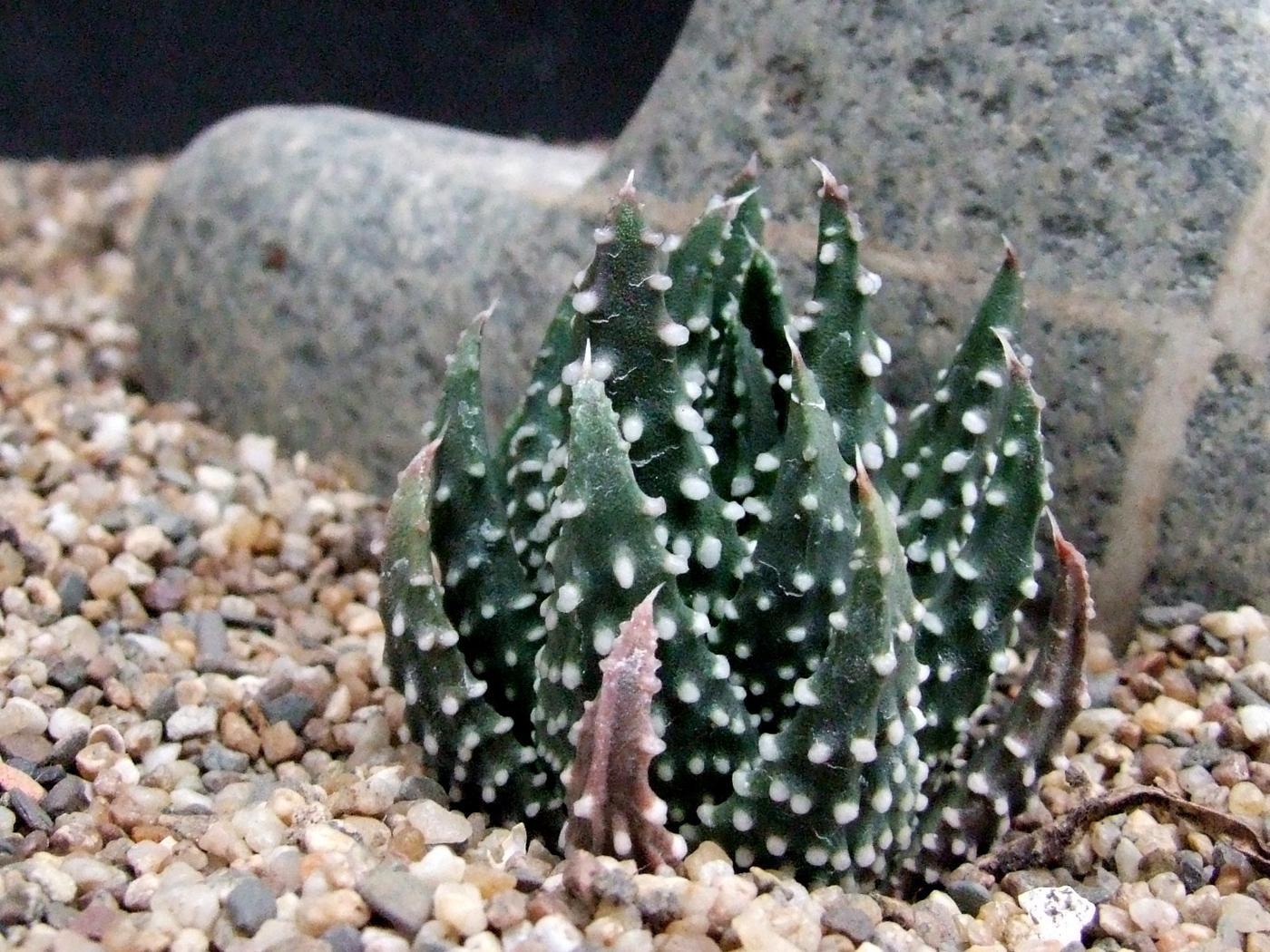
Uses and display: Haworthia pumila can grow easily on window sills, verandas and in miniature succulent gardens where they are happy to share their habitat with other smaller succulent plants or in outdoor rockeries.
Haworthias are small, making them beautiful additions to succulent and cactus dish gardens.
Haworthia pumila occurs in a winter rainfall area, which experiences mild frost, -2°C (28°F). Summers are hot, up to 44°C (111°F). Rainfall varies from 150mm (6 inch) (Worcester area) to 350mm (14 inch) (Montagu area). Haworthia pumila is not an endangered plant.
Description: Haworthia pumila is one of the most impressive and eventually large species of the genus. Haworthia pumila has triangular, rather tough, dark green leaves thickly spotted with pearly white warts. Stems are very short and the many leaved rosettes, which can attain a diameter of 15cm (6 inch) and a height of 7-10cm (3-4 inch), appears to be stemless. A cluster of rosettes form quickly (within about a year). The lower, older leaves of each rosette stand erect, but younger ones toward of the rosette centre curve inward. The 7mm (0.3 inch) thick leaves are about 9cm (3 inch) long and 3cm (1 inch) wide at the base. Leaf upper surfaces are flat, while the undersides are keeled toward the tips.
The flowers are somewhat larger than in other species, greenish to brownish-white in colour and waxy in texture (usually Haworthia flowers are white, but not in this case). The booming season is early summer and seed ripens in autumn.
Houseplant care: Haworthia pumila are classified as succulent – which means that they can cope with relatively harsh waterless hot environments. They are however not frost hardy, which means that for cultivation they need over the winter season either a sunny windowsill or preferably a greenhouse.
They are relatively slow-growing plants that offsets to form small clusters with time.
Light: Never place Haworthia pumila in direct sunlight. If exposed to summer sun, foliage will shrivel. Medium light suits this plant at all times. When the plants are provided with enough light, than the white tubercles from the leaves became more attractive.
It is recommended to move these house plants outdoors for the summer months. Place them in light shaded area, but out of direct sun which can scorch its leaves.
Temperature: Normal room temperatures 18-24°C (65-75°F) spring through fall. They have a rest period from mid-winter to late spring and can survive temperatures down to 4-5°C (39-41°F). In winter, if possible, keep Haworthia pumila cooler – around 15°C (59°F) is the optimum winter temperature for this plant.
Water: During the active growth period water moderately, enough to make the potting mixture moist throughout but allowing the top centimeter (0.4 inch) or so to dry out between waterings. During the rest period water only enough to prevent the potting mixture from drying out completely. Never let the potting mixture become completely dry, however. Although Haworthia pumila are succulent plants, they cannot survive total drought.
Feeding: It is neither necessary nor advisable to feed Haworthia pumila .
Longevity: Haworthia pumila plants live for about 30 to 40 years if they are cultivated properly.
Potting and repotting: Use a porous potting mixture composed of one part of coarse sand or perlite to two parts of standard soil-based mixture. Since Haworthia pumila plants are shallow rooted, half-pots are best suited to the clustering habit of the plants. In potting a specimen always leave a 4-5cm (1.5-2 inch) space between the edges of the cluster and the rim of the pot to allow room for new growth.
Repot in spring at the start of the growth period. After pulling or cutting off any dead or shriveled leaves, move each plant into a larger pot only if the rosette cluster covers the entire surface of the potting mixture. The largest pot size needed will be 12-15cm (5-6 inch). A plant that has grown beyond that size should be split up.
Gardening: Although the plant will survive mild frost if kept dry – hardy as low -2°C (28°F) – it should be protected from severe cold and prolonged frost conditions.
Position: Haworthia pumila requires light shade to bright light, protected from strong midday sun. In shade the body colour will remain mostly green, while full sun will darken it and give it red/brown body colour.
The amount of sunlight it can withstand without scorching depends upon the how hot it becomes in the summer in the locale in which it is planted. It will have more colour if it receives more light. During the spring it may be able to take full sun until the heat arrives at the end of spring. In an area that has hot afternoon sun, it may be able to take full morning sun, but requires afternoon shade or afternoon light shade. Can be sunburned if moved from shade/greenhouse into full sun too quickly.
Soil: Haworthia pumila are tolerant of a wide range of soils and habitats, but prefer a very porous potting mix to increase drainage. A non-acid soil is ideal.
Irrigation: Watering varies depending on the plants position and temperature. Water them frequently when it is warm and dry (but not at the very peak of the heat- they seem to go through a period of summer dormancy at this time) and less to not at all in winter when it is cold. However, Haworthia pumila plants or pots with succulent plants communities are sitting under the grey skies of winter storms and get a lot of rainwater at a time when they are probably mostly dormant. It seems that it is not be a problem for these plants.
Individual plants in smaller pots demand more attention. Water ideally when soil is getting dry and not if wet. When in doubt, best to skip watering as too much is worse than too little. Some pots dry out faster than others, too (if glazed, unglazed terracotta, metal, glass etc – all dry out at different rates).
Fertilising: Do NOT fertilize newly potted plants for the first year. After that, fertilize once in spring, once in fall with diluted fertiliser at half the recommended strength. Avoid summer fertilizing as plant is in a short rest period.
Propagation: Remove the offsets in summer; they should pull away easily. Pot up immediately any offset with roots already attached and treat it as a mature plant.
Allow an offset without roots to dry for three days, however, then press it into the potting mixture. At this stage it should be possible to treat the new plant as an adult Haworthia pumila.
To propagate by leaf cuttings, remove a leaf and let it lie for about one month, giving the wound time to heal. Then lay the leaf on its side with the basal part buried in the soil. This leaf should root within a month or two, and small plants will form at the leaf base.
Haworthia pumila grow readily from seed. These plants have a tendency to hybridize so easily, however, that the results are likely to be unpredictable. Haworthia pumila grows relatively slowly from seed and it takes about 5 years for a plant to reach flowering maturity.

Problems: Given correct treatment, this plant is generally trouble free.
Stunted growth may indicate mealy bags infestation.
Treatment: Occasional watering with systemic insecticides based on Imidacloprid will keep the plants free of mealy bugs.
Rot is only a minor problem with Haworthia if the plants are watered and “aired” correctly. Haworthia species can lose their roots periodically. They can rot with too much moisture, especially when there is a sudden temperature drop.
Treatment: There are two ways to handle this:
1. Simply leave the plant on its side and when ‘bumps’ which are the new roots start to appear (It may take a few weeks), pot the plant in soil and water normally. Mist it occasionally for encouragement.
2. The second method is more like how it happens in nature and is my preferred method. Be sure the plant is in well-draining soil and water normally. In a month or so, gently tug and feel the roots taking hold–if the roots are not holding, don’t worry. Just put the plant back in the soil and wait a little longer.
If the plant has lost its roots and is severely dehydrated at the same time, it may be too far gone to save. But always it is worth a try.
When watering, avoid getting the leaves wet. Like other succulents, it is prone to rot if its leaves get too wet. If they are not, fungicides won’t help all that much. Care must be given in watering, keeping them warm and wet while growing and cooler and dry when dormant.
Reddish colour can mean many things besides root loss. Many of Haworthia turn red when the temperature drops or when they get too much sunlight. A plant can loose their reddish colour turning in green later as the environment condition are changed.

Uses and display: Haworthia pumila can grow easily on window sills, verandas and in miniature succulent gardens where they are happy to share their habitat with other smaller succulent plants or in outdoor rockeries.
Haworthias are small, making them beautiful additions to succulent and cactus dish gardens.
0
0
成长记
kensong
2019年07月02日

I now added "Haworthia Fasciata Elegans White Variegation" in my "garden"


0
0


